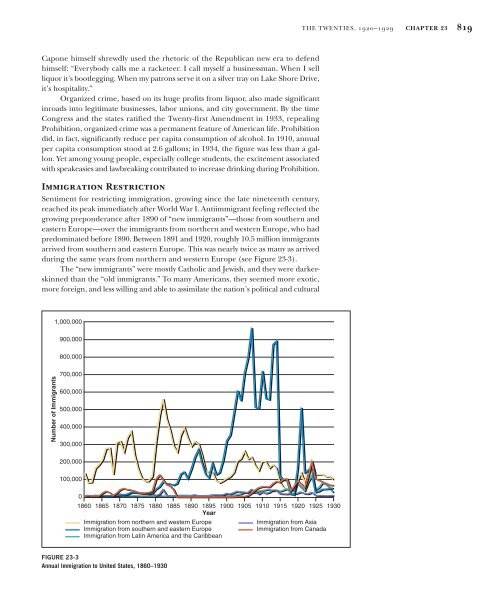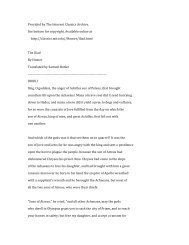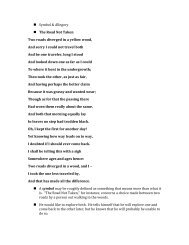71193_23_ch23_p0800-0843 4/12/10 4:21 PM Page 819THE TWENTIES, 1920–1929 CHAPTER 23 819Capone himself shrewdly used the rhetoric of the Republican new era to defendhimself: “Everybody calls me a racketeer. I call myself a businessman. When I sellliquor it’s bootlegging. When my patrons serve it on a silver tray on Lake Shore Drive,it’s hospitality.”Organized crime, based on its huge profits from liquor, also made significantinroads into legitimate businesses, labor unions, <strong>and</strong> city government. By the timeCongress <strong>and</strong> the states ratified the Twenty-first Amendment in 1933, repealingProhibition, organized crime was a permanent feature of American life. Prohibitiondid, in fact, significantly reduce per capita consumption of alcohol. In 1910, annualper capita consumption stood at 2.6 gallons; in 1934, the figure was less than a gallon.Yet among young people, especially college students, the excitement associatedwith speakeasies <strong>and</strong> lawbreaking contributed to increase drinking during Prohibition.Immigration RestrictionSentiment for restricting immigration, growing since the late nineteenth century,reached its peak immediately after World War I. Antiimmigrant feeling reflected thegrowing preponderance after 1890 of “new immigrants”—those from southern <strong>and</strong>eastern Europe—over the immigrants from northern <strong>and</strong> western Europe, who hadpredominated before 1890. Between 1891 <strong>and</strong> 1920, roughly 10.5 million immigrantsarrived from southern <strong>and</strong> eastern Europe. This was nearly twice as many as arrivedduring the same years from northern <strong>and</strong> western Europe (see Figure 23-3).<strong>The</strong> “new immigrants” were mostly Catholic <strong>and</strong> Jewish, <strong>and</strong> they were darkerskinnedthan the “old immigrants.” To many Americans, they seemed more exotic,more foreign, <strong>and</strong> less willing <strong>and</strong> able to assimilate the nation’s political <strong>and</strong> cultural1,000,000900,000800,000Number of Immigrants700,000600,000500,000400,000300,000200,000100,00001860 1865 1870 1875 1880 1885 1890 1895 1900 1905 1910 1915 1920 1925 1930YearImmigration from northern <strong>and</strong> western EuropeImmigration from southern <strong>and</strong> eastern EuropeImmigration from Latin America <strong>and</strong> the CaribbeanImmigration from AsiaImmigration from CanadaFIGURE 23-3Annual Immigration to United States, 1860–1930
71193_23_ch23_p0800-0843 4/12/10 4:21 PM Page 820820 CHAPTER 23 THE TWENTIES, 1920–1929QUICK REVIEWRestrictions on ImmigrationImmigration Act of 1921 reducedimmigration <strong>and</strong> established quotasfor nationalities.Immigration Act of 1924 restrictedimmigration on the basis of nationalorigins.New laws became a permanent featureof national policy.In this excerpt, President CalvinCoolidge proclaims the details withinthe National Origins Quota Act, 1924.Whereas it is provided in the act ofCongress approved May 26, 1924, entitled“An act to limit the immigrationof aliens into the United States, <strong>and</strong>for other purposes” that— “<strong>The</strong> annualquota of any nationality shall be two percentum of the number of foreign-bornindividuals of such nationality residentin continental United States as determinedby the United States censusof 1890, but the minimum quota of anynationality shall be 100 . . .Immigration Act 1921 act setting amaximum of 357,000 new immigrantseach year.values. <strong>The</strong>y were also relatively poorer, more physically isolated in the nation’s cities,<strong>and</strong> less politically strong than earlier immigrants. In the 1890s, the anti-CatholicAmerican Protective Association called for a curb on immigration, <strong>and</strong> by exploitingthe economic depression of that decade, it reached a membership of 2.5 million. In1894, a group of prominent Harvard graduates, including Henry Cabot Lodge <strong>and</strong>John Fiske, founded the Immigration Restriction League, providing an influentialforum for the fears of the nation’s elite. <strong>The</strong> league used newer scientific arguments,based on a flawed application of Darwinian evolutionary theory <strong>and</strong> genetics, to supportits call for immigration restriction.<strong>The</strong>ories of scientific racism, which had become more popular in the early1900s, reinforced antiimmigrant bias. <strong>The</strong> most influential statement of racial hierarchywas Madison Grant’s <strong>The</strong> Passing of the Great Race (1916), which distorted genetictheory to argue that America was committing “race suicide.” According to Grant,inferior Alpine, Mediterranean, <strong>and</strong> Jewish stock threatened to extinguish the superiorNordic race that had made America great. Eugenicists, who enjoyed considerablevogue in those years, held that heredity determined almost all of a person’scapacities, <strong>and</strong> that genetic inferiority predisposed people to crime <strong>and</strong> poverty. Suchpseudoscientific thinking sought to explain historical <strong>and</strong> social development solelyas a function of “racial” differences.Against this background, the war <strong>and</strong> its aftermath provided the final push forimmigration restriction. <strong>The</strong> “100 percent American” fervor of the war years fuelednativist passions. So did the Red Scare of 1919–20, which linked foreigners withBolshevism <strong>and</strong> radicalism of all kinds in the popular mind. <strong>The</strong> postwar depressioncoincided with the resumption of massive immigration, bringing much hostile commenton the relationship between rising unemployment <strong>and</strong> the new influx of foreigners.<strong>The</strong> American Federation of Labor proposed stopping all immigration fortwo years. Sensational press coverage of organized crime figures, many of them Italianor Jewish, also played a part.In 1921, Congress passed the Immigration Act, setting a maximum of 357,000new immigrants each year. Quotas limited annual immigration from any Europeancountry to 3 percent of the number of its natives counted in the 1910 U.S. census.But restrictionists complained that the new law still allowed too many southern <strong>and</strong>eastern Europeans in, especially since the northern <strong>and</strong> western Europeans did notfill their quotas. <strong>The</strong> Johnson-Reed Immigration Act of 1924 revised the quotas to2 percent of the number of foreign-born counted for each nationality in the censusfor 1890, when far fewer southern or eastern Europeans were present in theUnited States. <strong>The</strong> maximum total allowed each year was also cut, to 164,000. <strong>The</strong>quota laws did not apply to Canada, Mexico, or any other nation in the westernhemisphere.<strong>The</strong> 1924 Immigration Act also included a clause prohibiting the entry of “aliensineligible to citizenship,” thereby excluding immigrants from the nations of East <strong>and</strong>South Asia. Since nearly all Asians had already been barred from legal immigration,either by the Chinese Exclusion Act of 1882 or the “barred Asiatic zone” created byCongress in 1917, the 1924 clause was in fact, aimed at the exclusion of Japaneseimmigrants. An outraged Japanese government retaliated by imposing a 100 percenttariff on goods imported from America. This new restriction dovetailed withtwo recent Supreme Court decisions, Ozawa v. U.S. (1922) <strong>and</strong> U.S. v. Thind (1923),in which the Court held that Japanese <strong>and</strong> Asian Indians were unassimilable aliens<strong>and</strong> racially ineligible for U.S. citizenship. By the 1920s, American law had thus createdthe peculiar new racial category of “Asian,” <strong>and</strong> codified the principle of racialexclusion in immigration <strong>and</strong> naturalization law.





